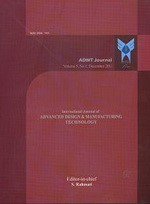-
-
List of Articles
-
Open Access Article
1 - Two Dimensional Simulation of Laminar Flow Around Two Bodies in Relative Motion
sahar noori F. Mahdavi S.M.H. Karimian -
Open Access Article
2 - Dynamic Load Carrying Capacity of Spatial Cable Suspended Robot: Sliding Mode Control Approach
Moharam Habibnejad korayem M. Jalali H. Tourajizadeh -
Open Access Article
3 - Exergy Analysis of a Trigeneration System Driven by Aninternal Combustion Engine with Asteam Ejector Refrigeration System
mohammad najafi K. Javaherdeh B. Liravinia -
Open Access Article
4 - Investigation of Oxygen Enriched air intake on diesel engine exhaust emissions
Mojtaba Amirshekari -
Open Access Article
5 - Stress Analysis of Tractor Tire Interaction whit Soft Soil using Non-linear 2D Finite Element Method
Moslem Namjoo Naser Nankali -
Open Access Article
6 - A New method for Production of Porous Aluminum Castings
A.K. Shaik Dawood1 -
Open Access Article
7 - Potential of a Low Heat Rejection Diesel Engine with Renewable Fuels
venkata murthy M.V.S. Krishna -
Open Access Article
8 - Prediction of Rupture Using Ductile and MSFLD Damage in T- Shape Tube Hydro-Forming Process
hossein ghazavi Nosratollah Solhjoei -
Open Access Article
9 - The effect of orientation on optimum insulation position in the wall of a building with natural ventilation in hot and dry climate
mehdi najafian Alireza Bahrami -
Open Access Article
10 - Anisotropy Induced Biaxial Stress-Strain Relationships in Aluminum Alloys
Milad Janbakhsh Mohammad Riahi Faramarz Djavanroodi -
Open Access Article
11 - Experimental Investigation of Surface Roughness for Fused Deposition Modelled Part with Different Angular Orientation
sreedhar pugalendhi -
Open Access Article
12 - Evaluation of the Heat and Mass Transfer and Exergy in the Counter Flow Wet Cooling Tower of Khuzestan Steel Company (KSC)
Navid Bozorgan Nariman Bozorgan -
Open Access Article
13 - Microstructure and Mechanical Properties of Al2O3-SiC Nanocomposites with 0.05% MgO and Different SiC Volume Fraction
Ali Reza Moradkhani Mehdi Tajdari
-
The rights to this website are owned by the Raimag Press Management System.
Copyright © 2021-2025







